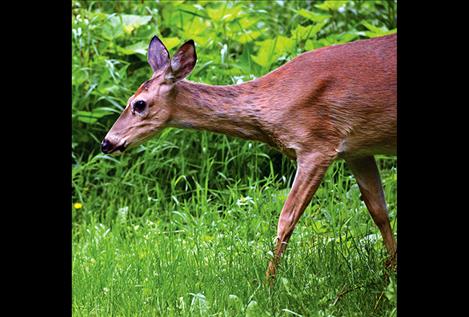Try deer-resistant plants for gardens
Hey savvy news reader! Thanks for choosing local.
You are now reading
1 of 3 free articles.
Mule and whitetail deer are abundant these days over much of our region. As many of us have experienced, deer can do a lot of damage to a garden in a short time. In spring and summer they eat flowers and foliage. In winter, deer browse on the young shoots and buds of shrubs and trees. Deer prefer some plants over others, but if they are starving, they will eat almost any plant. Some of their firstchoice favorites are tulips, roses, pansies, arborvitae and young fruit trees.
An eight-foot (or higher) fence is the best protection for garden plants, but fences are not always practical or attractive in certain locations. Some popular deer repellents are: human hair, dog hair, scented soaps, blood meal, egg yolks mixed with water, thiram fungicide, and sprinklers activated by movement. Deer repellents are not always effective and usually have to be reapplied after rain. Often, deer seem to get accustomed to a repellent’s odor and will eventually return to browsing the garden. Strongly scented soaps worked for quite a while for me, but eventually the deer returned and I ended up with heaps of water-soaked bars of soap decorating my planting borders.
Vegetable and fruit gardens probably need to be fenced in our area, but if you are growing ornamental plants only, why not choose deer-resistant species adapted to our climate? That way you can have a beautiful garden deer will (for the most part) leave alone. The term “deer-resistant” means that the species listed here are less preferred as food than other commonly grown garden plants. These plants are often fragrant, or poisonous, or irritate a deer’s stomach, so are not as often eaten. I have indicated the common name, species name and USDA coldest climate zone:
Annuals: – Ageratum, Cleome hasslerana
– Dusty miller (Senecio cinerara), Fibrous begonias
– Heliotrope (Heliotropum spp.), Marigolds (Tagetes spp.)
– Poppies (Papaver spp.), Scented geraniums (Pelargonium spp.
– Sweet alyssum (Lobularia maritma), Zinnias
Bulbs: – Alliums zone 3, Daffodils (Narcissus spp.) zone 4
– Fritillaria imperialis zone 4, Lily of the Valley (Convallaria spp.) zone 3
– Scillas zone 4, Snowdrops (Galanthus spp.) zone 3
Perennials: – Anise hyssop (Agastache foeniculum) zone 4
– Astilbe spp. zone 4
– Bee balm (Monarda spp.) zone 4
– Bleeding heart (Dicentra spectabilis) zone 3
– Bugleweed (Ajuga spp.) zone 4
– Butterfly bush (Buddleia spp.) zone 5
– Butterfly weed (Asclepias tuberosa) zone 3
– Columbine (Aquilegea spp.) zone 3
– Coneflower (Echinacea spp.) zone 3
– Coreopsis spp. zone 3 – Delphinium elatum zone 3
– False Indigo (Baptisia australis) zone 3
– Hardy geraniums (Geranium spp. ) zone 4
– Hellebores (Helleborus spp.) zone 4
– Liatris spicata zone 3
– Lamium maculatum zone 2
– Lamb’s ears (Stachys byzantina) zone 4
– Penstemon barbatus zone 4
– Penstemon eatonii zone 4
– Penstemon pinifolius zone 4
– Perennial poppies (Papaver orientale) zone 3
– Rudbeckia fulgida zone 4
– Red valerian (Centranthus ruber) zone 3
– Russian sage (Perovskia atriplicifolia) zone 4
– Speedwell (Veronica spicata) zone 3
– Vinca minor zone 3
– Yarrow (Achillea spp.) zone 3
– Yucca glauca zone 3
Shrubs and trees: – Barberry (Berberis koreana) zone 3
– Barberry (Berberis thunbergii) zone 4
– Caragana spp. zone 2
– Colorado blue spruce (Picea pungens) zone 3
– Forsythia spp. zone 4
– Juniper (Juniperus spp.) zone 3,4
– Lavender (Lavandula angustifolia) zone 4-5
– Lilac (Syringa spp.) zone 3
– Mockorange (Philadelphus lewisii) zone 3
– Mugho pine (Pinus mugho) zone 2 – Red osier dogwood (Cornus sericea) zone 2 – Rosa foetida and R. foetida bicolor zone 3
– Rosa pimpinellifolia and hybrids zone 3
– Scots pine (Pinus sylvestris)
















